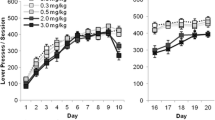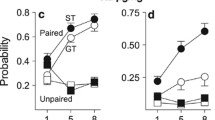Abstract
Both amphetamine and scopolamine increase low rates and reduce high rates of responding. It has been suggested that the dependence of the effects of these drugs on control rate may be due to their non-specific disruptive cue properties rather than to specific pharmacological actions. To examine whether this possible non-specific disruption also applied to response-choice, pigeons were trained under a schedule in which 30 key-peck responses were required. This fixed-ratio could be completed by responding in any order on either or both of two keys, and then the first switch between the two keys was reinforced by the presentation of food. Under control conditions, the probability of the birds switching between the keys increased as the ratio progressed, resulting in performance which could be analysed in a manner analogous to rate-dependent analyses of responding under fixed-interval (FI) schedules. The birds were then treated with amphetamine (0.4–3.2 mg/kg), chlorpromazine (1.0–30 mg/kg) and scopolamine (0.01–0.10 mg/kg). Amphetamine increased switching at all baselines, to probabilities greater than chance (i.e.P. switch >0.5). Scopolamine resulted in response choice converging towards chance, whereas chlorpromazine reduced switching when the baseline probabilities were high. Thus: i) amphetamine increases switching in pigeons as it has previously been shown to do in rats, and this effect is not due to regression towards random choice, ii) the opposite effect of a reduction in switching can occur after chlorpromazine treatment, and iii) whereas the effects of amphetamine and scopolamine on response rate may be similar, the effects of the two drugs on response choice are dissociable, with only scopolamine resulting in a randomisation of performance.
Similar content being viewed by others
References
Brown K, Warburton DM (1971) Attenuation of stimulus sensitivity by scopolamine. Psychon Sci 22:297–298
Dews PB, Wenger GR (1977) Rate-dependency of the behavioral effects of amphetamine. In: Thompson T, Dews PB (Eds), Advances in behavioral pharmacology vol 1. Academic Press, New York pp 167–223
Evenden JL (1984) A behavioural and pharmacological analysis of response selection. Unpublished PhD thesis, University of Cambridge
Evenden JL, Robbins TW (1983a) Dissociable effects ofd-amphetamine, chlordiazepoxide and alpha-flupenthixol on choice and rate measures of reinforcement in the rat. Psychopharmacology 79:180–186
Evenden JL, Robbins TW (1983b) Increased response switching, perseveration and perseverative switching followingd-amphetamine in the rat. Psychopharmacology 80:67–73
Evenden JL, Robbins TW (1985) The effects ofd-amphetamine, chlordiazepoxide and alpha-flupenthixol on food-reinforced tracking of a visual stimulus by rats. Psychopharmacology 85:361–366
Ferster CB, Skinner BF (1957) Schedules of reinforcement. Appleton-Century-Crofts, New York
Ksir C (1981) Rate-convergent effects of drugs. In: Thompson T, Dews PB (eds) Advances in behavioral pharmacology, vol 3. Academic Press, New York pp 39–59
Laties VG (1972) The modification of drug effects on behavior by external discriminative stimuli. J Pharmacol Exp Ther 183:1–13
Laties VG, Wood RW, Cooper Rees D (1981) Stimulus control and the effects ofd-amphetamine in the rat. Psychopharmacology 75:277–282
McKim WA (1981) Rate-dependency: a nonspecific behavioral effect of drugs. In: Thompson T, Dews PB, McKim WA (eds) Advances in behavioral pharmacology vol 3. Academic Press, New York pp 61–73
Milar KS (1981) Cholinergic drug effects on visual discriminations: a signal detection analysis. Psychopharmacology 74:383–388
Moerschbaecher JM, Thompson DM, Thomas JR (1979) Effects of methamphetamine and scopolamine on variability of response location. J Exp Anal Behav 32:255–263
Robbins TW (1982) Behavioural determinants of drug action, In: Cooper SJ (Ed) Theory in psychopharmacology Vol 1. Academic Press, New York pp 1–63
Robbins TW, Evenden JL (1985) Rate-independent approaches to the analysis of drug action. Proceedings of the First European Meeting for the Analysis of Behaviour. In: Lowe CF, Richelle M, Blackman DE, Bradshaw CM (eds) Behaviour analysis and contemporary psychology. Laurence Erlbaum, London, pp 217–256
Robbins TW, Watson BA (1981) Effects ofd-amphetamine on response repetition and win-stay behaviour in the rat. In: Bradshaw CM, Szabadi W, Lowe CF (Eds) Quantification of steadystate operant behaviour. Elsevier/New Holland, Amsterdam pp 441–444
Todorov JC, Gorayeb SRP, Correa GL, Graeff FG (1972) Effects of amphetamine on choice behaviour of pigeons. Psychopharmacologia 26:395–400
Author information
Authors and Affiliations
Rights and permissions
About this article
Cite this article
Evenden, J.L. Contrasting baseline-dependent effects of amphetamine, chlorpromazine and scopolamine on response switching in the pigeon. Psychopharmacology 89, 421–427 (1986). https://doi.org/10.1007/BF02412114
Received:
Revised:
Issue Date:
DOI: https://doi.org/10.1007/BF02412114




